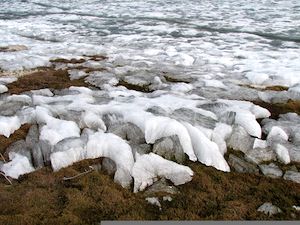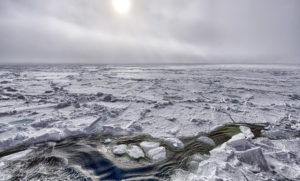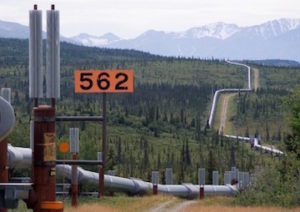Greening Tundra Shows Arctic Heat
Arctic vegetation is now growing nearly 500 miles closer to the North Pole than it was a few decades ago, indicating that the region is warming fast.
By Tim Radford, Climate News NetworkThis piece first appeared at Climate News Network.
LONDON — The Arctic is on the move. The North Pole is in the same place, but Arctic conditions have begun to shift. A study of 30 years of satellite data confirms that the difference in temperatures between the seasons has diminished.
Conditions now have shifted the equivalent of four or five degrees of latitude southward. At the same time, vegetation has moved north, colonizing the thawing permafrost.
A team of 21 scientists from 17 institutions in seven nations reports in Nature Climate Change that as the cover of snow and ice has diminished and retreated in the Arctic Circle, the temperatures have begun to increase – at differing rates – during the four seasons. Although conditions differ from region to region, overall the growing season is beginning earlier, and the autumn freeze is starting later.
Conditions in northern latitudes now increasingly resemble those found several hundred miles further south 30 years ago. One of the authors, Bruce Forbes of the University of Lapland in Finland, told the Climate News Network that in his own research region of north-west Siberia “we are seeing more frequent and longer-lasting high pressure systems. In winter, the snow cover comes later, is deeper on average than in the 1960s, but is melting out earlier in spring.”
Climate is a complicated business, and there is always legitimate room for argument about the validity of one selected set of measurements, a potential bias in the observations, or the reliability of comparison data collected two generations earlier.
But vegetables can’t be fooled. Plants grow where they can. If deciduous shrubs are growing taller, and colonizing sites ever further north, then conditions must be getting warmer, and staying warmer.
Winners – and losers
Professor Forbes says that indigenous reindeer herders report that alder and willow, normally stunted by the polar winter, are growing taller: his own research team has confirmed this with dendrochronology, the science of tree ring measurement.
“In a few decades, if the current trends continue, much more of the existing low shrub tundra will start to resemble woodlands as the shrubs become tree-sized”, he says.
This enhanced warming over a longer ground-thaw season has changed the landscape: it has, says Compton Tucker of the Goddard Space Flight Center in the US, “created during the past 30 years large patches of vigorously productive vegetation, totaling more than a third of the northern landscape – over nine million km2, which is roughly about the area of the USA – resembling the vegetation that occurs further to the south.”
This warming of the high latitudes is not necessarily good news for all plants. As the tundra turns green at an accelerating rate, the growth of the boreal forests – those mighty stands of conifer species that cover northern Canada and northern Eurasia and enclose the Arctic Circle – may even be decelerating.Boreal forest species are adapted to cold. “Some areas of boreal forest will be negatively impacted by warming temperatures, from increased drought stress as well as insect and fire disturbance”, says Scott Goetz of Woods Hole Research Center in the US, another of the co-authors.
“But this work shows that in most high latitude regions we see increased productivity resulting from a reduced range of seasonal temperature variability.”
Driving more warming
Since relative temperatures are dictated by latitude, the researchers used latitude as a measure. They selected reference sites and studied both change, and the rate of change, using three decades of Nasa satellite data, and reports from researchers and nomad observers.
One of these sites was at 64° N. Now, 30 years on, it has plant cover characteristic of 57° N. It is as if growing conditions had shifted seven degrees north, or very nearly 750 km, according to Terry Chapin, of the University of Fairbanks, Alaska.
By the end of the century, at the present rate of change, temperature seasonality will have diminished substantially, and – once again using latitude as a yardstick – will be the equivalent of a 20 degrees shift, relative to measurements made between 1951 and 1980.
Such warming is all too likely to feed back into even more global warming, as the frozen soils of the north come to life, peat and vegetation begin to decompose, and yet more reservoirs of buried methane and carbon dioxide are released into the atmosphere.
What it will mean to the peoples and the creatures of the north is hard to guess, because ecosystems will change with seasonal temperature and plant growth.
“Think of the migration of birds to the Arctic in the summer and the hibernation of bears in the winter”, says Dr Goetz. “Any significant aberrations in seasonality are likely to impact life not only in the north, but elsewhere, in ways that we do not know.”
Your support matters…Independent journalism is under threat and overshadowed by heavily funded mainstream media.
You can help level the playing field. Become a member.
Your tax-deductible contribution keeps us digging beneath the headlines to give you thought-provoking, investigative reporting and analysis that unearths what's really happening- without compromise.
Give today to support our courageous, independent journalists.






You need to be a supporter to comment.
There are currently no responses to this article.
Be the first to respond.